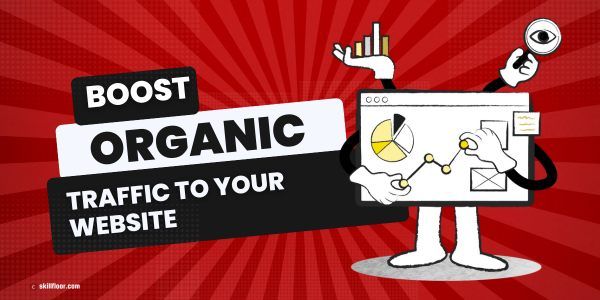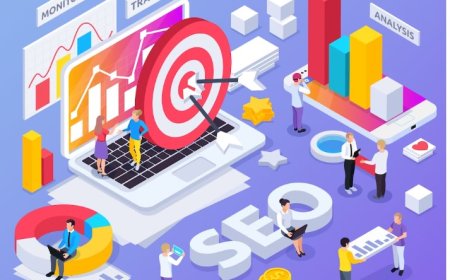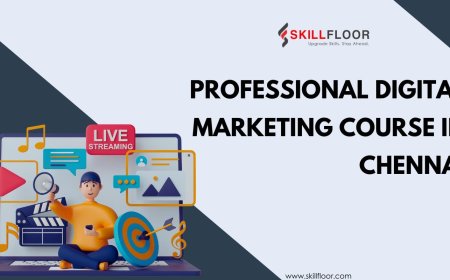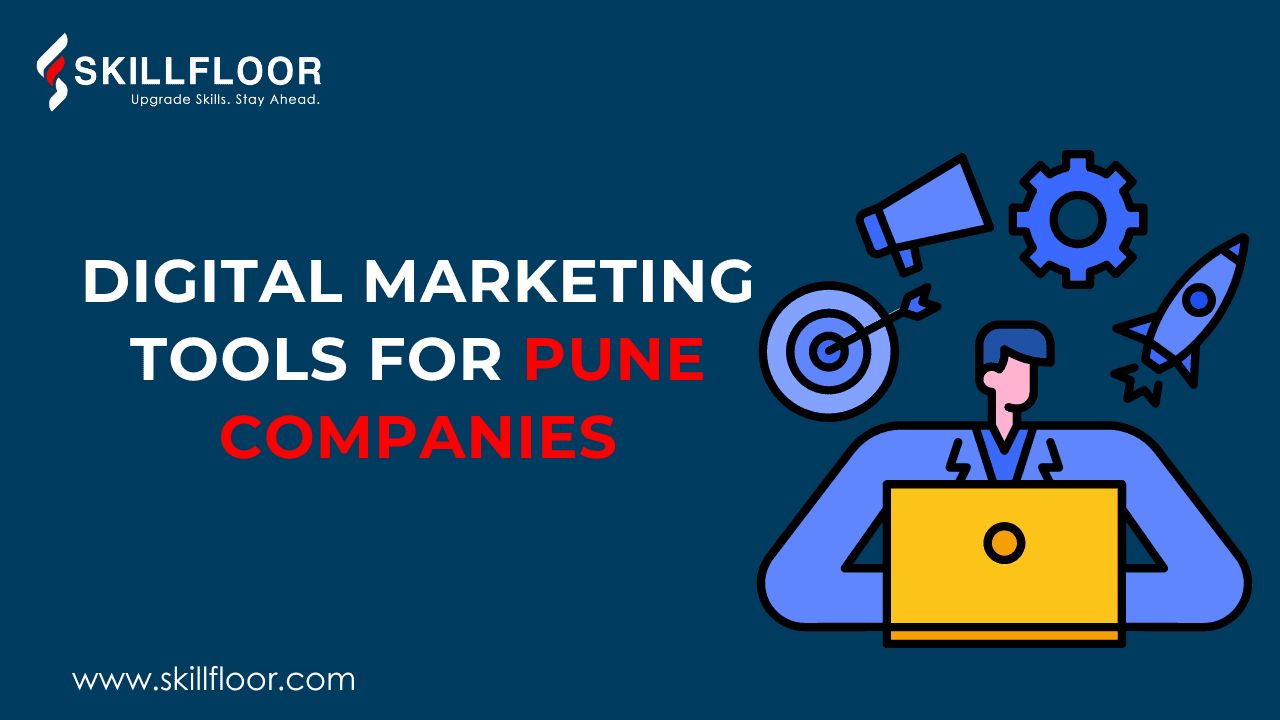How to Boost Organic Traffic to Your Website
Learn effective strategies to boost organic traffic to your website, including SEO optimization, high-quality content creation, and social media engagement.

As a digital marketing expert, I've seen firsthand how crucial organic traffic is for the success of any website. It’s the lifeblood of online visibility and ultimately drives conversions, leads, and sales. Unlike paid advertising, organic traffic is built on the foundation of search engine optimization (SEO) and quality content. However, boosting organic traffic can feel like a rising battle in today's competitive digital environment. Many businesses struggle with it, often feeling overcome by the ever-changing algorithms and SEO best practices.
The Challenge of Visibility
One of the main challenges I’ve encountered—and that many others face—is understanding the intricacies of SEO and how to implement strategies that work effectively. The digital environment is active, and what worked yesterday might not yield the same results today. Moreover, many website owners invest a significant amount of time and resources into their content without seeing a noticeable increase in traffic. This lack of results can lead to frustration and discouragement, prompting them to question the effectiveness of their digital marketing strategies.
How can you effectively boost organic traffic to your website?
Let’s dive into the strategies that can significantly boost organic traffic to your website.
1. Optimize On-Page SEO
The first step in improving organic traffic is to ensure your website is optimized for search engines. Here’s how I approach on-page SEO:
Keyword Research
I start by conducting thorough keyword research. Tools like Google Keyword Planner, SEMrush, and Ahrefs are invaluable for identifying keywords that align with my content and audience intent. I focus on finding relevant keywords with good search volume but relatively low competition. This way, I can target keywords that my audience is actively searching for, increasing the chances of ranking higher on search engine results pages (SERPs).
Meta Tags and Descriptions
Crafting compelling meta titles and descriptions is another vital step. These elements should not only include the target keywords but also encourage users to click through to my content. A well-written meta description acts as a mini-ad for my content and can significantly influence click-through rates (CTR).
Header Tags
I ensure to use header tags (H1, H2, H3) effectively to structure my content. This not only enhances readability but also helps search engines understand the hierarchy of information on my page. I make sure my primary keyword is included in the H1 tag, while related keywords can be incorporated into the H2 and H3 tags.
Image Optimization
Images play a critical role in engaging users. I optimize images by using descriptive filenames and alt tags, which improve accessibility and enhance SEO. Additionally, I compress images to ensure they load quickly without compromising quality.
Benefits of On-Page SEO
-
Improved Search Engine Rankings
By aligning your content with search engine algorithms through on-page SEO practices, you increase your chances of ranking higher in search results. Higher rankings translate to greater visibility and more organic traffic. -
Enhanced User Experience
Optimized content not only helps search engines but also improves user experience. Well-structured content with proper headers, optimized images, and fast load times make your site more user-friendly, leading to longer visit durations and lower bounce rates. -
Higher Click-Through Rates (CTR)
Meta titles and descriptions act as a call to action in SERPs. A compelling description with the right keywords encourages users to click on your link over others, driving more traffic to your site. -
Better Targeting of Audience Intent
Thorough keyword research allows you to understand and match your audience's search intent. By optimizing your content to align with their needs, you attract more qualified leads who are likely to engage with and convert on your site. -
Increased Accessibility and Reach
Optimizing images with alt text not only aids visually impaired users but also helps search engines index these images. This boosts your overall SEO efforts and expands the reach of your content to a wider audience, including image search results. -
Faster Load Times
Compressing images and optimizing content for speed leads to faster load times, which is a key ranking factor. Pages that load quickly provide a better user experience and are less likely to drive users away, which contributes to a stronger SEO performance.
2. Create High-Quality Content
Creating valuable, high-quality content is at the heart of my digital marketing strategy. Here’s how I approach it:
Valuable Information
I focus on providing in-depth, relevant information that addresses the needs and questions of my audience. Quality content attracts more backlinks and shares, further boosting my SEO. I aim for my content to be informative, actionable, and tailored to my audience’s interests.
Regular Updates
Regularly updating my blog or website with fresh content is crucial. Search engines favor sites that consistently publish new content. I try to maintain a content calendar to ensure I’m regularly updating my site, whether through new blog posts, articles, or even minor updates to existing pages.
Engaging Formats
I incorporate different content types such as infographics, videos, and interactive content. This variety caters to different audience preferences and increases engagement, which can lead to longer visit durations and lower bounce rates.
Implementing high-quality content creation boosts SEO, engagement, and conversions. Here’s how:
-
SEO Performance: In-depth, updated content improves search rankings, and keyword visibility, and attracts backlinks.
-
Audience Engagement: Varied content formats (infographics, videos) increase time on site, lower bounce rates, and encourage social sharing.
-
Backlinks: High-value content attracts backlinks, enhancing domain authority and organic search visibility.
-
Conversions: Regular, relevant updates build trust, improving conversion rates.
-
Brand Awareness: Shareable content enhances visibility, positioning your brand as a trusted authority.
-
User Experience: Diverse formats cater to user preferences, ensuring better engagement and satisfaction.
This approach strengthens SEO, drives traffic, and supports business growth.
3. Build Backlinks
Backlinks are a significant ranking factor for search engines. Here’s how I build them:
Guest Blogging
Writing guest posts for reputable sites in my niche is a strategy I actively pursue. This not only helps build backlinks but also increases my visibility among a broader audience. I always aim to provide valuable insights in my guest posts to establish credibility and encourage readers to visit my site.
Networking
I connect with other bloggers and influencers in my field. Building relationships can lead to collaborative opportunities and backlinks. Engaging with others in my niche can foster a sense of community and mutual support, which often translates to link-sharing.
Content Sharing
I actively promote my content through social media and email newsletters. Sharing my articles and blog posts on social platforms increases visibility and can lead to more backlinks from interested parties. When my content is shared, it reaches a wider audience, which can result in organic traffic growth.
Usages of Building Backlinks
-
Improved Search Engine Rankings: Backlinks enhance your site’s authority, leading to higher rankings on search engine results pages.
-
Enhanced Website Traffic: Guest posts and shared content create pathways for users to discover your site, driving referral traffic.
-
Establishing Authority and Credibility: Contributing to reputable sites builds trust and positions you as an expert in your niche.
-
Networking and Relationship Building: Engaging with bloggers and influencers opens doors for collaborations and additional backlink opportunities.
-
Increased Brand Awareness: Promoting your content on social media and newsletters broadens your audience and encourages link-sharing.
-
Content Optimization Insights: Analyzing backlink sources helps refine your content strategy to focus on what resonates with your audience.
-
Long-term Benefits: Quality backlinks can drive traffic over time, enhancing your site's ongoing SEO performance.

4. Enhance User Experience (UX)
User experience is paramount when it comes to retaining visitors and encouraging repeat traffic. Here’s what I focus on:
Mobile Responsiveness
Ensuring my website is mobile-friendly is non-negotiable. With a significant amount of traffic coming from mobile devices, I’ve prioritized responsive design. A mobile-optimized site enhances user experience and can improve search engine rankings.
Site Speed
I optimize my website for speed, as a slow-loading site can frustrate users and lead to higher bounce rates. I use tools like Google PageSpeed Insights to analyze my site’s performance and implement recommendations to enhance loading times.
Clear Navigation
Designing a user-friendly navigation structure is key to improving user experience. Easy access to information encourages users to explore my site further, reducing bounce rates and increasing the likelihood of conversions.
Combined Impact:
Together, mobile responsiveness, site speed, and clear navigation create a foundation for an excellent user experience. This leads to:
-
Repeat Visitors: A positive experience encourages users to return, increasing the chances of repeat traffic.
-
Higher Conversions: Easier navigation, faster load times, and a mobile-optimized interface reduce barriers to conversion, making it simpler for users to take desired actions.
-
Better SEO: These elements improve your website’s technical and user-related metrics, which search engines consider when ranking sites. This results in higher organic visibility, driving more traffic over time.
Ultimately, by focusing on these areas, you create a website that not only attracts visitors but also retains them and encourages them to take meaningful actions, contributing to long-term business growth.
5. Utilize Social Media
Social media plays a vital role in boosting organic traffic. Here’s how I leverage it:
Share Content
I actively share my blog posts and articles on social media platforms where my audience is present. This drives traffic back to my website and increases visibility. By using engaging visuals and compelling captions, I encourage users to click through to my content.
Engagement
I make it a priority to engage with my audience on social media. Responding to comments and questions helps build a community around my brand. This interaction not only fosters loyalty but also encourages users to share my content within their networks.
Boost Website Traffic
Sharing content on social media and engaging with your audience provides several benefits that directly impact your website's performance. Here’s how these strategies contribute to your on-site success:
1. Increased Website Traffic
-
Sharing content on social media gives your audience direct access to your site, driving more visits. The more engaging your posts (with visuals and captions), the higher the likelihood of click-throughs, leading to increased organic traffic.
-
Engagement, such as comments and interactions, keeps your content circulating in user feeds, increasing your content’s reach and bringing more people to your site.
2. Improved SEO
-
Social signals, such as likes, shares, and comments, though not direct ranking factors, indirectly support SEO. Higher website traffic signals to search engines that your site is valuable, which can improve your search rankings.
-
When people share your content or link back to your site on social media, it can lead to backlinks, a crucial SEO factor.
3. Lower Bounce Rate
-
Users arriving from social media are often more targeted and interested in your content because they’ve chosen to click through. This can reduce your bounce rate (the percentage of users who leave your site quickly), as visitors are more likely to spend time reading your posts, interacting with your site, or exploring further.
4. Boosted Brand Awareness and Recognition
-
Regularly sharing and engaging on social media boosts brand awareness. As more users recognize and trust your brand, they’ll be more inclined to visit your website directly or search for your brand-related content, contributing to increased direct traffic.
5. Higher Conversion Rates
-
Social media helps create a community and build trust. When users interact with your brand and experience consistent, positive engagement, they’re more likely to visit your website with a readiness to convert—whether that’s making a purchase, subscribing, or signing up for a service.
6. Data Insights and Retargeting Opportunities
-
Traffic driven from social media can offer valuable insights into your audience’s preferences and behavior on your site. This data allows you to tailor future content or use retargeting strategies to bring these users back to your site, increasing the chances of conversion.
In essence, social media acts as a funnel to bring targeted, engaged users to your site, where they’re more likely to stay longer, interact with your content, and convert into leads or customers. This organic integration strengthens your overall digital presence, creating a seamless path between your social activity and your website's performance.
6. Leverage Local SEO
If your business has a local presence, local SEO is essential. Here’s how I implement it:
Google My Business
Setting up and optimizing my Google My Business (GMB) profile is a top priority. This enhances local search visibility and helps potential customers find me easily. I ensure my profile is complete, including accurate contact information, business hours, and engaging images.
Interesting Fact: Businesses with a complete GMB listing are 70% more likely to attract location visits from searchers. Additionally, reviews and ratings on GMB can significantly influence potential customers’ decisions.
Local Keywords
Incorporating local keywords into my content is another strategy I employ. This helps attract local traffic and ensures that my content is relevant to users in my area. For example, if I’m targeting a local audience, I include city names and local phrases in my content.
Helpful Insight: According to Google, 76% of people who search for something nearby visit a business within a day. By using local keywords, I can connect with these users at the right moment when they are most likely to make a purchase.
Additional Local SEO Strategies
Local Citations
Building local citations involves listing my business on online directories like Yelp, Yellow Pages, and other local business directories. This not only enhances my online presence but also contributes to local search rankings.
Benefit: Consistent citations across various platforms can boost credibility and trust with search engines. This can lead to improved rankings in local search results.
Reviews and Ratings
Encouraging customers to leave reviews on my GMB profile and other review sites is crucial. Positive reviews can enhance my business’s reputation and increase visibility.
Interesting Insight: Businesses with positive reviews can experience a 5-10% increase in sales. Reviews not only influence customer decisions but also impact local search rankings.
Mobile Optimization
With the increasing use of mobile devices for local searches, optimizing my website for mobile is essential. A mobile-friendly site ensures a smooth user experience and can significantly improve search rankings.
Fact: Google prioritizes mobile-friendly websites in its search results. Therefore, a well-optimized mobile site can lead to higher visibility and increased traffic.
Local Content Creation
Creating content that resonates with local audiences, such as blog posts about local events, news, or community stories, can further enhance my local SEO strategy.
Helpful Tip: Localized content can drive organic traffic and encourage engagement, as it appeals to the interests and needs of the community.
Incorporating these local SEO strategies not only improves visibility and drives traffic but also fosters community connections. By making local SEO a central part of my digital marketing strategy, I can enhance customer engagement and ultimately drive business growth.
7. Monitor and Analyze Performance
Monitoring and analyzing website performance is essential for refining digital marketing strategies. Here’s an expanded look at how this practice can enhance overall effectiveness and drive better results.
Use Analytics Tools
Using tools like Google Analytics and Search Console goes beyond basic tracking. Here are some additional facts that underscore their significance:
-
Comprehensive Insights: Google Analytics provides insights into user demographics, interests, and geographic locations. This data allows for more targeted marketing efforts, ensuring content resonates with specific audiences.
-
Conversion Tracking: By setting up goals within Google Analytics, you can track conversion rates effectively. Understanding which pages lead to conversions enables you to replicate successful elements across your site.
-
Real-Time Data: Both Google Analytics and Search Console offer real-time data monitoring, allowing for quick adjustments in campaigns. Immediate insights can help respond to trending topics or changes in user behavior promptly.
-
Search Performance: Google Search Console reveals how well your site performs in search results. You can identify which queries lead users to your site, helping refine content and improve click-through rates.
-
User Behavior Analysis: Tools like heatmaps (e.g., Hotjar, Crazy Egg) can visually show how users interact with your site, highlighting areas where visitors spend the most time and where they drop off. This knowledge can guide UX improvements.
Adjust Strategies
Being proactive in adjusting your strategies based on performance data is crucial. Here are some points to consider:
-
A/B Testing: Implement A/B testing for various elements like headlines, calls to action, and layouts. Testing different versions can reveal what resonates more with your audience, leading to higher engagement and conversion rates.
-
Keyword Optimization: Regularly revisiting your keyword strategy ensures you stay relevant. Search trends change; therefore, identifying emerging keywords or shifts in user intent allows you to capture more organic traffic.
-
Content Refresh: If specific content underperforms, consider updating it with current information, improved visuals, or a different format (e.g., turning a blog post into an infographic). This not only enhances user experience but also signals to search engines that the content is fresh.
-
Segmentation: Analyzing data by segments (e.g., new vs. returning visitors, traffic sources) helps tailor content and offers to different user groups, increasing relevance and engagement.
-
Competitor Analysis: Monitoring competitors' performance using tools like SEMrush or Ahrefs can provide valuable insights. Understanding their strategies allows you to identify gaps in your approach and capitalize on opportunities.
Boosting organic traffic to your website is a multifaceted process that requires a strategic approach. By optimizing on-page SEO, creating high-quality content, building backlinks, enhancing user experience, leveraging social media, implementing local SEO, and continuously monitoring performance, you can effectively increase your organic traffic over time.
Remember, it’s essential to stay updated with the latest SEO trends and algorithm changes. What works today may not yield the same results tomorrow. However, by focusing on providing value to your audience and adopting a long-term strategy, you can navigate the complexities of the digital landscape and achieve sustained growth in organic traffic.
As a digital marketing expert, I encourage you to start implementing these strategies today. The journey to boosting your organic traffic may take time, but the results are worth the effort. You’ll not only see an increase in visitors but also build a loyal audience that values your content and engages with your brand.





























































